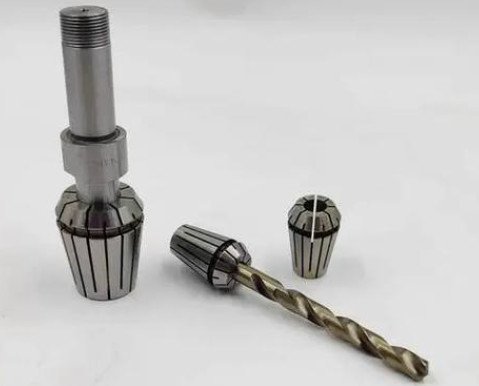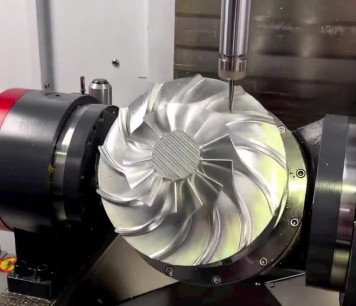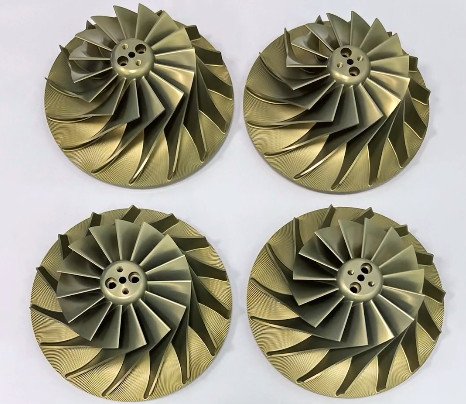Spring collets are precision workholding devices essential in machining, woodworking, and manufacturing. They securely grip cylindrical workpieces or tools, such as drills, end mills, or lathe centers, ensuring high concentricity, quick tool changes, and reliable clamping. This article provides a detailed technical overview of spring collets, including their structure, types, specifications, applications, and maintenance, tailored for professionals seeking systematic and accurate information.
Basic Structure and Working Principle
A spring collet is a cylindrical clamping device designed to hold tools or workpieces with precision. Its unique structure allows it to contract and grip under external force, then return to its original shape when released, hence the name "spring collet." The key components of a spring collet include:
- Collet Body: A cylindrical sleeve with longitudinal slots (typically 3–6) cut into one end, forming flexible "fingers" that enable expansion and contraction.
- Tapered Outer Surface: The outer diameter features a conical taper that matches the corresponding taper in a collet chuck or machine spindle.
- Inner Bore: The inner diameter is precision-machined to grip specific tool or workpiece sizes (e.g., 6 mm, 1/4 inch).
Working Principle: When inserted into a tapered collet chuck or spindle, axial force—applied via a drawbar, nut, or hydraulic/pneumatic actuation—causes the collet’s tapered outer surface to engage with the chuck’s taper. This interaction compresses the collet’s fingers inward, securely gripping the tool or workpiece. The uniform clamping force minimizes runout and prevents deformation. Releasing the force allows the collet to spring back to its original shape, releasing the grip.
The design ensures high concentricity (often <0.0005 inches or 0.013 mm), making spring collets ideal for precision machining tasks requiring minimal deviation from the central axis.
Types of Spring Collets
Spring collets are categorized by their taper standards, which vary by region, machine type, and application. The most common types include R8, ER, 5C, Morse Taper (MT), and others, each with specific characteristics and uses.
| Collet Type | Taper Standard | Gripping Range | Common Applications |
|---|---|---|---|
| R8 | 16° per side | 1/16–1 inch (1.6–25.4 mm) | Bridgeport-style milling machines |
| ER | 8° | 0.5–34 mm (varies by size, e.g., ER32: 3–20 mm) | CNC milling, turning, drilling |
| 5C | 1.5 inches per foot | 1/32–1 inch (0.8–25.4 mm) | Lathes, grinders, fixture work |
| Morse Taper (MT) | Varies (MT0–MT6) | 3–50 mm | Lathes, drill presses |
| Brown & Sharpe (B&S) | Smaller tapers | 1–25 mm | Precision lathes |
R8 Collets: Common in the US, R8 collets are used in Bridgeport-style milling machines. Their 16-degree taper and incremental sizing (1/16-inch steps) make them suitable for manual milling.
ER Collets: Developed by Rego-Fix, ER collets (e.g., ER8, ER16, ER32, ER40) are globally popular due to their versatility. Each collet can grip a range of diameters (e.g., ER32 covers 3–20 mm), reducing the need for multiple collets.
5C Collets: Widely used in North American lathes and grinders, 5C collets offer high precision for cylindrical workpieces. They support a wide range (1/32–1 inch) and include step collets for larger diameters.
Morse Taper (MT) Collets: Based on the Morse taper standard, these collets (MT0–MT6) are used in lathes and drill presses, particularly for heavier machinery.
Brown & Sharpe (B&S) and Metric Collets: B&S collets are used in precision lathes, while metric collets (e.g., DIN 6388) cater to metric-sized tools, common in European and Asian markets.
Technical Specifications
Spring collets are defined by precise specifications to ensure compatibility and performance. Key parameters include size, taper angle, gripping range, material, and runout.
| Parameter | Description | Typical Values |
|---|---|---|
| Collet Size | Diameter and length of the collet body | ER16: 16 mm dia.; ER40: 40 mm dia. |
| Taper Angle | Angle of the conical outer surface | 8° (ER), 16° (R8), 1.5 in/ft (5C) |
| Gripping Range | Range of tool/workpiece diameters | 0.5–34 mm (varies by type) |
| Material | Composition for durability | Spring steel, carbide, alloy steel |
| Runout | Maximum deviation from concentricity | 0.005–0.015 mm (precision grades) |
Collet Size: Sizes are standardized to match specific chucks or spindles (e.g., ER16, 5C). Larger collets (e.g., ER40) handle bigger tools or workpieces.
Taper Angle: Varies by collet type, ensuring a secure fit with the machine’s spindle or chuck. For example, ER collets use an 8-degree taper, while R8 uses 16 degrees.
Gripping Range: ER collets offer the widest range (e.g., 1 mm increments), while R8 and 5C collets are more specific (e.g., 1/16-inch steps).
Material: High-grade spring steel is common for its balance of elasticity and strength. Carbide or alloy steel is used for high-wear applications.
Runout: Precision collets achieve runout as low as 0.005 mm, critical for high-tolerance machining in industries like aerospace.
Key Features and Advantages
Spring collets offer several advantages that make them indispensable in precision manufacturing:
- High Concentricity: Precision-ground collets ensure minimal runout (<0.0005 inches or 0.013 mm), critical for accurate machining.
- Quick Changeover: Collets allow faster tool or workpiece changes compared to jaw chucks or clamps, reducing setup time.
- Uniform Clamping Force: The slotted design distributes force evenly, preventing deformation of delicate workpieces.
- Versatility: Available in various sizes and tapers, collets accommodate different machines and materials, including metal, wood, and plastic.
- Durability: Made from high-quality materials, collets withstand high forces and repeated use.
Applications
Spring collets are used across diverse industries due to their precision and reliability:
- Machining: Used in CNC milling, turning, drilling, and grinding to hold tools (e.g., end mills, drills) or workpieces. ER collets are common in CNC environments.
- Woodworking: Router collets secure bits in routers for cutting, shaping, and engraving wood.
- Automation: Collets grip small components in robotic assembly lines, ensuring precision in high-volume production.
- Aerospace and Medical: Used for manufacturing high-tolerance parts, such as bolts, turbine blades, or surgical tools, where precision is critical.
- Fixture Work: 5C collets are used in fixtures for inspection or secondary operations, holding workpieces securely.
Selection Criteria
Choosing the appropriate spring collet requires careful consideration of several factors:
- Machine Compatibility: Ensure the collet matches the machine’s spindle or chuck taper (e.g., R8 for Bridgeport mills, ER for CNC spindles).
- Gripping Range: Select a collet that accommodates the tool or workpiece diameter. For example, an ER32 collet can grip 3–20 mm.
- Material and Coating: Choose materials like carbide for high-wear applications or coated collets (e.g., TiN) for enhanced durability.
- Precision Requirements: High-tolerance applications (e.g., medical devices) require collets with low runout (≤0.005 mm).
- Clamping Force: Heavy-duty tasks (e.g., rough milling) need collets with high gripping strength, such as TG collets.
Maintenance and Care
Proper maintenance extends the life and performance of spring collets:
- Cleaning: Remove debris, coolant, and chips from slots and surfaces after use to ensure proper clamping.
- Inspection: Check for wear, cracks, or deformation in the collet body and slots. Replace damaged collets to avoid runout or slippage.
- Storage: Store in a dry, organized environment using protective sleeves or racks to prevent rust or damage.
- Lubrication: Apply anti-corrosion oil to steel collets during storage to prevent rust.
- Proper Handling: Avoid overtightening the chuck, as excessive force can deform the collet or damage the taper.
Common Issues and Solutions
While reliable, spring collets can encounter issues that affect performance:
- Tool Slippage: Caused by incorrect collet size or insufficient clamping force. Use the correct collet size and tighten to manufacturer specifications.
- Excessive Runout: Results from worn collets, debris, or improper installation. Clean and inspect collets regularly, replacing damaged units.
- Difficulty in Tool Release: Occurs with overtightened or contaminated collets. Use proper torque and clean collets before use.
- Collet Wear: Prolonged use or mishandling can degrade performance. Implement a maintenance schedule and replace worn collets.

Conclusion
Spring collets are critical components in precision manufacturing, offering high concentricity, quick changeovers, and reliable clamping across machining, woodworking, and automation applications. Understanding their design, types, specifications, and maintenance ensures optimal performance and longevity. By selecting the right collet and addressing common issues, professionals can achieve consistent, high-quality results in demanding manufacturing environments.



